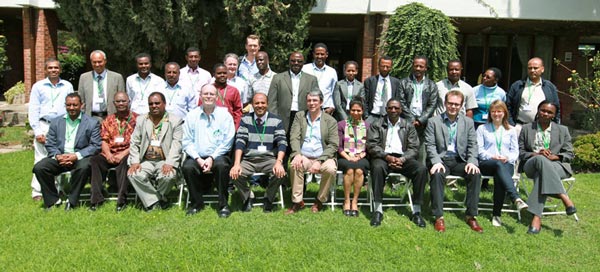During 27-28 April 2012, CIMMYT’s Socioeconomics Program organized a formulation meeting in Addis Ababa, Ethiopia for its Technology Adoption and Intensification Pathways project. More than 35 participants from five African countries attended the meeting. The group included economists, agronomists, and breeders, drawn from CIMMYT; the Australian Center for International Agricultural Research (ACIAR); the International Food Policy Research Institute (IFPRI); the International Livestock Research Institute (ILRI); national agricultural research institutions; the University of Queensland, Australia; the Norwegian University of Life Sciences (UMB); and universities from member countries of the Sustainable Intensification of Maize-Legume Cropping Systems for Food Security in Eastern and Southern Africa (SIMLESA) project. The objectives of the meeting were to discuss the project proposal with stakeholders, reflect on the in-house review comments by ACIAR, and develop the full proposal by developing a clear impact pathway. The four-year project is expected to develop actionable strategies and policy options for technology targeting and facilitating the adoption of integrated interventions.
The director of the Australian International Food Security Centre (AIFSC), Mellissa Wood, gave a keynote address on “New opportunities for enhancing food security in Africa”. She noted that food security remains an ongoing challenge in Africa, to which Australia is well placed to contribute thanks to its agricultural research expertise. The Australian Government has therefore renewed its focus on food security through rural development initiatives and the establishment of AIFSC. She pointed out that AIFSC’s mission is to accelerate demand-driven research, delivery and adoption of innovations to improve food security, by bridging the gap through agricultural research; understanding the requirements of smallholder production systems; understanding constraints to adoption of research outputs; and devising new modalities to overcome such constraints.
The meeting also benefited from key presentations by CIMMYT, partner institutions, and universities on key topics; break-out group discussions; and a brainstorming session. The new project has four main objectives: (1) panel data collection in sentinel villages and understanding of barriers to technology adoption; (2) risk analysis and adaptation options to manage climate risk and variability; (3) impact assessment and analysis of household intensification pathways; and (4) capacity building in gender-disaggregated agricultural policy analysis and communication of results.


